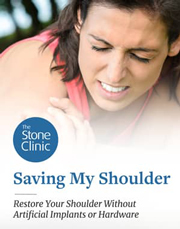Shoulder Dislocations
First-time shoulder dislocations are painful and scary. To repair immediately, or not to repair at all, is the most common question I get. Here is the data:

To dislocate a shoulder, the labrum (the gasket that holds the shoulder in place) must be torn away from the bony glenoid, or socket, of the shoulder. Once torn, it doesn’t self-heal. The athlete must decide to either live with the torn labrum—and an increased chance of repeat dislocation—or repair it. No amount of shoulder strengthening will prevent repeat episodes.
The most recent data [i] indicates that if the athlete is under 15 years old, the recurrence rate (within 10 years after the initial injury) is 39% and 47% for 16 to 20-year-olds. Patients between 31 and 40 had just an 18% chance of recurrent instability, but a 16% chance of symptomatic arthritis.
Making the right choice for each person requires knowing both the bias of their surgeon and the activities and expectations of the patient. I, personally, am biased towards immediate repair. Why? Two reasons: It is an outpatient repair taking less than an hour, with very few complications; and I am good at it. I want to help my patients get back to full sports, and I worry about another dislocation in dangerous situations. My surfing and kayaking patients, for instance, dislocate on tricky waves and in fast-moving rivers. Kayakers especially get into a “high brace” position, where they are leaning back and holding the paddle overhead in whitewater conditions. A repeat dislocation in such a situation can be life-threatening. Similar situations occur for surfers on big waves, skiers in the backcountry and on steep pitches, kite surfers in the bay, and a host of other athletes. And not just their life is at risk, but their long-term health as well. It cannot be good for any joint to sublux in and out, scraping across the articular cartilage and wearing down the tissues.
If a repair can solve that situation, it should be done immediately. Unfortunately, the repairs themselves are not without risk. The recurrence rate even after surgical repair can be as high as 25%—though that includes repairs done by a wide range of surgeons with varying abilities. Optimal repair and rehabilitation should lead to a much lower recurrence rate—and that has indeed been our experience over the last 30 years.
The type of repair matters. Careful reattachment of the labrum and selective tightening of the capsule of the joint can restore normal shoulder motion. Too tight a capsule, or too loose a repair, leads to failure. The sutures and anchors used today are much more effective, and with a lower profile, than those used in the past.
A rehabilitation program must start on Day One after surgery and be guided carefully to regain motion and strength while the tissues are healing. To accelerate healing, we add growth factors from the patient’s own blood (PRP) and other sources. Growth factors and special proteins called cytokines have been shown to recruit the body’s own stem cell-derived repair cells to the site of injury. This aspect of the science of tissue healing is advancing rapidly and should help athletes return to sports faster than they have in years past.
With the combination of anatomic repair and biologic augmentation, the healing of dislocated shoulders should not be left to chance. That is our, admittedly biased, view. But since it is your shoulder, you get to choose.
Sources
[i] Leland DP, Bernard CD, Keyt LK, Krych AJ, Dahm DL, Sanchez-Sotelo J, Camp CL. An age-based approach to anterior shoulder instability in patients under 40 years old: analysis of a UP population. AM J Sports Med. 2020 Jan;48(1):56-62. Epub 2019 Nov 22.
Experiencing Undiagnosed Shoulder Pain? Use our Shoulder Pain Symptom Checker to better understand your symptoms and find out possible injury conditions.

